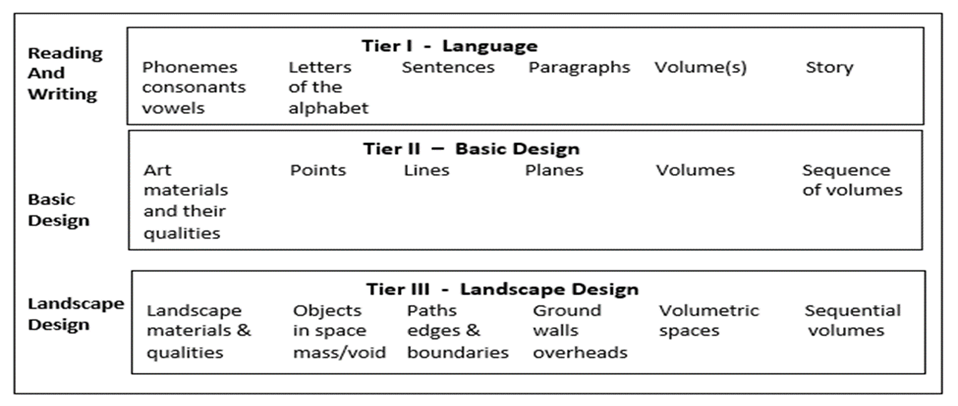I can’t remember how I got from those realizations, those clarifications of what expresses good design experiences, to what I came to call The Analogy but somehow, I arrived at the development of a three-tiered learning tool that integrates language, basic design, and landscape design (Scarfo, 2022, 18). Here is a quick introduction to The Analogy. How deeply you dive into it is up to you. As noted, it is a tool that facilitates learning about design; learning how to express statements and messages in built environments that call for and speak to people’s experiences.

In The Analogy’s Language Tier, phonemes, morphemes, consonants, and vowels provide the basic features and qualities by which we identify form and the words we write and speak in order to express ourselves. Metaphorically, in basic design such qualities are the viscosity of paint, the crystalline structure of stone, the tooth of paper. In landscapes such qualities are things like the porosity of soil, the shape of stone, clarity of water. How, where, and why we use these qualities reflect a design’s participants’ anticipated experiences. As you look at the three-tiered analogy graphic you can throw a dart or just pick something in one tier and begin asking how the selected thing is comprised, used, combined with other features and then begin asking how each of those aspects of the selected item are found in each of the other two tiers.
Given the second item along the Language Tier, I fluctuate between “Letters of the Alphabet” and “words.” But even that uncertainty is worth serious contemplation. How do seemingly very different landscape features express sensations and messages they don’t seem to as a first impression? How does the fact that certain letters of the alphabet sound like words (e.g., b, c, o, t) cause us to consider and explore similar qualities in Basic Design and Landscape Design. Can landscape features be explicit and implicit? Can something like depth and distance be manipulated to make something appear deeper or shorter than it is? What about trompe-l’œil? I’ll never forget finding out that a winter scene in a movie was actually shot in the summer. The actor and actress, in an outdoor setting, would each take a mouthful of ice and just before speaking their lines, spit out the ice and then express their words with the accompanied vapor making it look like a colder environment than it was.
